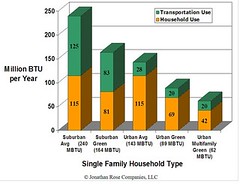Sprawl vs. Green Urban
I don't know what it is about those of us that work for positive placemaking and compact development objectives. Clearly, we are not as prolific as the pro-sprawl writers such as those representing the Reason Foundation (see "Myths About Suburbia and Our Car-Happy Culture," from the Washington Post, January 28, 2007) or Joel Kotkin's latest piece in yesterday's paper, "Hot World? Blame Cities."
The latest piece from Kotkin is such a crock that it makes you wonder if the Post's Outlook editor looks at the submissions in terms of accuracy. They would be good examples of faulty argumentation for a class in argumentative writing (English 225 at the University of Michigan), because of claiming to argue about one thing while discussing something else.
While it is true that cities do have a heat island effect, in terms of the overall generation of carbon and energy use, these days (but not during the days of early industrialization) cities are far friendlier to the planet--at least in North America. It's likely that cities elsewhere, especially in China, are still anti-environment cesspools.
And imagine if China begins to approach the U.S. in terms of per capita energy consumption. The U.S. consumes 25% of the world's energy, even though it has but 5% of the world's population. China has 20% of the world's population. If China consumed energy at the same rate as the U.S., then between the U.S. and China, the two countries would consume 125% of the world's energy production... I don't know what the other 75% of the world would do, not to mention China and the U.S. So I can't imagine that U.S. suburban land use and transportation patterns are going to remain tenable in the face of possibly declining energy resources.
Also see the article "Green Manhattan."
Labels: energy, environment




0 Comments:
Post a Comment
<< Home